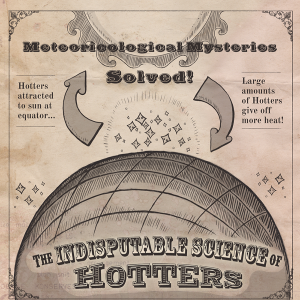A speech by Professor Wilbur Wilkinson-Grauss, as provided by George Nikolopoulos
Art by Leigh Legler
Mr. President, ladies and gentlemen, I sincerely wish to thank you for inviting me to speak here at the Royal Geographical Society.
I am going to speak to you about Hotters, the astounding minuscule creatures that provide us with heat. As you are undoubtedly aware of, Professor Eric Higgsbaum-Straddle and my humble self first predicted the existence of these elusive entities eight years ago, and we have since been trying to discover conclusive evidence of their existence. A few months ago, with the invaluable help of Dr. Richard Bottom-Wiggins’ remarkable new invention, the minutoscope, which, as you probably know, is a device that enables the human eye to observe minute creatures, we were able, for the first time in the history of humanity, to see the Hotters.
To be precise, Sir, we did not actually see individual Hotters, as the creatures are so tiny that they can not even be seen with the aid of the minutoscope–which can magnify the image of an object by up to 500 times–but we were able to perceive large clusters of Hotters on the surface of an iron alloy that we heated to 1,000 degrees in the absolute scale. As Professor Higgsbaum-Straddle and I have explained in our paper that was published in the Journal of the New Victorian Society, the attribute that we call “heat” is in fact generated by Hotters. The greater the concentration of Hotters in an object, the hotter the object becomes. According to our theory, Hotters are born in fire, and as the alloy was put through the fire, the Hotters leaped upon it.
I do not wish to tire you, Sir, with scientific details and calculations, which you will be able to peruse at your leisure in our paper in the Journal, but I am certainly obliged to mention that the concentration of Hotters in a substance is directly proportional to its absolute temperature, multiplied by a constant number, which we have named H, and is equal to 8.353 X 1023. It was proposed by our esteemed colleague, Professor Januarius Finnegan-Smythe, that this number be called the Higgsbaum-Straddle-Wilkinson-Grauss Constant.
To go on with my narrative, then, Sir, exactly as we had predicted, the concentration of Hotters on the alloy was great enough to allow us to observe clusters of Hotters on its surface. As you may have been informed of, Dr. Bottom-Wiggins and the New Lowland Laboratories are presently working on a new improved model of the minutoscope which will be able to magnify images by up to 2,000 times. Magnification on this scale will most probably be adequate for us to observe concentrations of Hotters on objects less than 300 degrees hot. If the illustrious Doctor continues to improve his minutoscope at such a rate, I believe I can safely predict that it will not be very long before we can actually observe individual Hotters.

We now recognize for a fact, Sir, that Hotters love the Sun, that they would rather reside near the equator, and that they migrate to the southern hemisphere in the winter. I have been asked by skeptics why Hotters eschew the Arctic Circle. Well, I replied, would you live in such a bleak and barren place? Hotters are very social creatures, and they prefer to reside where there is a congregation of Hotters already.
To read the rest of this story, check out the Mad Scientist Journal: Autumn 2014 collection.
Professor Wilbur Wilkinson-Grauss, OBE, first became known to the general public when he proposed the theory of Hotters, together with his less charismatic colleague, Professor Eric Higgsbaum-Straddle. Derided at first, the theory of Hotters soon became widely accepted by the scientific community and Prof. Wilkinson-Grauss is today hailed as the Father of Modern Heating.
George Nikolopoulos is a much published writer, poet, anthology editor, and sometimes actor from Greece. He is currently in search of an international career as a writer.
Leigh’s professional title is “illustrator,” but that’s just a nice word for “monster-maker,” in this case. More information about them can be found at http://leighlegler.carbonmade.com/.
Follow us online: